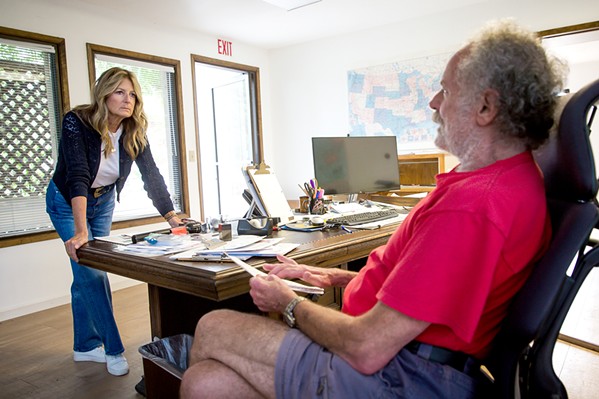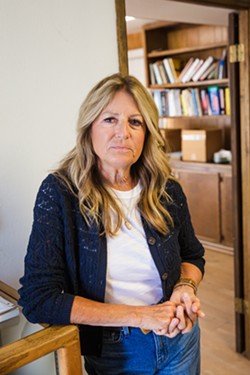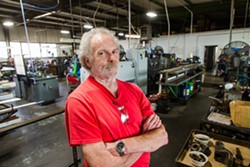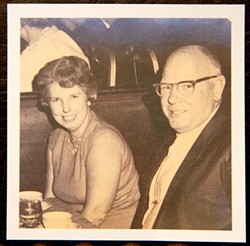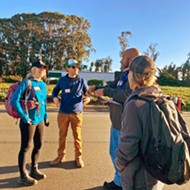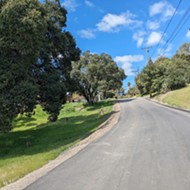Noll Inc. wants the regional water board to take accountability for wrongfully accusing it of contaminating groundwater
By Camillia Lanham[{
"name": "Newsletter Promo",
"id": "NewsletterPromo",
"class": "inlineCenter",
"insertPoint": "4",
"component": "15264767",
"requiredCountToDisplay": "0"
},{
"name": "Ad - Medium Rectangle CC01 - 300x250",
"id": "AdMediumRectangleCC01300x250",
"class": "inlineCenter",
"insertPoint": "8",
"component": "2963441",
"requiredCountToDisplay": "12"
},{
"name": "Ad - Medium Rectangle LC01 - 300x250",
"id": "AdMediumRectangleCC01300x250",
"class": "inlineCenter",
"insertPoint": "18",
"component": "2963441",
"requiredCountToDisplay": "22"
},{
"name": "Ad - Medium Rectangle LC09 - 300x250",
"id": "AdMediumRectangleLC09300x250",
"class": "inlineCenter",
"insertPoint": "28",
"component": "3252660",
"requiredCountToDisplay": "32"
}]
In the last four years, the Nolls have spent almost half a million dollars on consultants, investigatory reports, water bottles and filtration systems, well testing, and more.
Starting on July 31, 2019, the family lived under constant threat from the Central Coast Regional Water Quality Control Board: a fine of $5,000 a day for not complying with a cleanup and abatement order for pollution that the Nolls maintained from the beginning wasn't their fault.
Janice and John Noll, whose father founded Noll Inc. on Thread Lane near the San Luis Obispo airport in the early 1960s, did the groundwork they thought they needed to do to prove their company wasn't responsible for seeping TCE (trichloroethylene), a carcinogen, into the water table. Their father operated his machine shop with the utmost respect for the environment, a value that he passed down to his children. John, who now operates Noll Inc., said his machine shop has never used TCE.
"It was the worst kind of scenario for any kind of small business owner," John said. "If you get accused of polluting somebody's air—or water, in our case—that's the worst that it gets."
Hiring groundwater and environmental consultants and lawyers to conduct depositions with once-neighboring business owners, they complied with the order while also compiling everything their investigations yielded and submitting it to the water board. Often, it felt like those appeals fell on deaf ears. Sometimes, Janice said, the water board wouldn't even respond.
"It took letter after letter after letter," Janice said.
This summer, the water board finally rescinded its order against them, acknowledging the Nolls' "time and resources to provide safe drinking water to the residents of the Buckley Road community" in its July 2023 notice to the Nolls but not much else.
"I just feel like that's not enough for what happened," Janice said. "There will never be a public apology, there will never be anything that says, 'We're sorry that we didn't investigate further.'"
Those four years cost the Nolls more than money they might never recoup. It kept them up at night, put them at odds with their neighbors (some of whom they grew up with), and put them in danger of potentially losing their business and property. They were presumed guilty, Janice said, and not given a chance to prove their innocence.
"For me, I think fear was a huge thing. It was a huge unknown, and I had to ask myself, 'How can this be?' ... There is no evidence," she said. "I knew we weren't guilty, but I felt guilty of being responsible for the neighbors. I felt guilty for poisoning their water. I felt embarrassed and shameful."
"We had no recourse," she said.
Decades of pollution
The first time John ever heard of TCE was in January 1998, when he received a letter from the water board about the chemical being detected in the groundwater beneath the property next to Noll Inc.
"The closest apparent source of TCE is Noll's machine shop," the letter stated.
That letter demanded a list of all chemicals ever used at the machine shop and how they were stored and disposed of, soil samples, water samples, and soil and water chemical analyses.
It was a shock to John, who'd been working at the shop since he was 14 years old. Specializing in machining drive screws and their corresponding threads, which help put the motion in things like medical devices, Noll Inc. has been doing "basically the same thing" since the fall of 1961, he said. With the help of a nascent internet in 1998, John was able to search for the chemical to understand what TCE is and what it was used for.
The man-made solvent is commonly used as a metal degreaser, to clean rocket engines, and in the production of refrigerants, according to the California Office of Environmental Health Hazard Assessment. Also commonly used in dry cleaning, TCE is believed to cause cancer, reproductive harm, and more. On Oct. 23, 2023, the U.S. Environmental Protection Agency announced a proposal to ban TCE.
"We've always operated with the philosophy of No. 1, do no harm, and No. 2, leave no trace, and that's how we've always done business around here," John said. "I had intimate knowledge of all the operations and all the procedures, and the TCE was a total blindsider."
John said he invited investigators to tour the shop, look through his documents, and inspect operations. The water board didn't take him up on the offer, and that was the last he heard about TCE until 2014.
"It was bad enough that we were falsely accused by the ... water board of being the disposers, but the worst part was that no one had their water tested until 2014 or 2015, I believe," John said. "They sat there not knowing."
"If I had any idea how widespread the contamination was ... I would have started knocking on doors, but ... I thought that was the government's job," John added.
According to the Nolls' consultant, Michael Rendina from Avocet Environmental Inc., water board lab reports indicate that TCE was first detected beneath the property next to Noll Inc. in August 1995.
Central Coast Regional Water Quality Control Board Senior Engineering Geologist and Site Cleanup Program Manager Greg Bishop said the water board received a letter from John in 1998 claiming that TCE had never been used at 4665 Thread Lane (Noll Inc.) and urging the water board to investigate 795 Buckley Road (the neighboring property).
"For unknown reasons, the case became inactive until subsequent Central Coast Water Board staff became aware of elevated TCE concentrations in the Buckley Road area in 2013 during a public supply well investigation and subsequently began ordering investigations in the Thread Lane area," Bishop said in an emailed response to questions from New Times. "Staff have been open about this unfortunate delay by discussing it during multiple community engagement meetings."
From 2015 to 2020, according to the water board's Buckley Road Area TCE Cleanup and Abatement project landing page, the board conducted drinking water tests at 69 well locations in the area and initially found up to 14 wells impacted with TCE above drinking water level standards—5 micrograms per liter. The plume of TCE stretches from Thread Lane to Davenport Road and is a 1/2 mile to 1/3 of a mile wide.
"Results from the soil and gas investigation at 4665 Thread Lane did not reveal evidence for a surface discharge of TCE," the water board states on the landing page.
Groundwater sampling showed that deep below the Noll property, there were TCE concentrations of up to 783 micrograms per liter, 157 times greater than the drinking water standard and 10 times higher than adjacent properties, the board stated.
The big assumption
In the cleanup and abatement order issued against the Nolls in 2019, there were several pieces of evidence that regional water board staff used to support the conclusion that Noll Inc. caused the TCE pollution in the Buckley Road area. Two of the reasons included in the order: The shop property had the highest concentrations of the chemical in the groundwater below it, and "machining operations commonly use solvents as degreasing agents, including TCE."
Rendina became the Nolls' consultant after the water board issued that 2019 cleanup and abatement order. A certified engineering geologist and certified hydrogeologist, he once worked for Union Oil off Tank Farm Road. He worked on the big oil cleanup in Avila Beach and environmental investigations on the tank farm and got to know other geologists in the area, one of whom recommended that he and the Nolls work together.
Usually, Rendina said, he works with corporations, savvy clients who are able to weather the financial and legal storm that can come from dealing with regulatory agencies. For individuals, it's much more difficult. As the Nolls fought to get out from under the requirements that came with the 2019 order, they did their best to stay in compliance, testing wells in the area and ensuring their neighbors impacted by the pollution (including themselves) had replacement water.
"She was dealing with the cost and uncertainty and all the stress," Rendina said of Janice, who took the lead role in dealing with the board, public, and consultants. "And she was getting hassled by the bank. ... She was constantly being threatened with foreclosure or withdrawal of the commercial loan."
Janice said the bank was concerned about the liability that came from being pinpointed as a groundwater pollution source.
Rendina decided to work with the Nolls because he was convinced they weren't the source of the TCE pollution. He also thought there were a lot of holes in the water board's argument against them. The board's statement that machine shops "commonly use" solvents?
It implies that the Nolls were lying and must have used it, he said.
"That's very flimsy evidence. I've never seen a water board depend on something like that for an order," Rendina said. "The biggest thing that they ignored was there was no source evidence on the property."
During three rounds of testing, John said, there was never a positive test for TCE in the soil, soil gas, or on the surface at 4665 Thread Lane.
"They actually accused us of drilling a well hole just to dispose of TCE," John said of board staff. "We were kind of the last man standing, and we were a viable industry, and we were open and operating, and we were an easy target."
Rendina said that water board staff "came up with a theory that maybe they have a well on that property, and they're dumping it in the well."
"When you have to resort to that level of crazy hypotheses, then you're pretty desperate. And it was obvious that the water board was pretty desperate," Rendina said, adding that the evidence the water board relied on to pin pollution on the Nolls was circumstantial.
The water board also conducted tests on neighboring properties, including at the airport and 795 Buckley Road, which once held Central Coast Laboratories.
In an October 2019 letter to the Nolls, the water board stated that it was "aware of TCE use" at the 795 Buckley Road property. In 2017, the letter stated, staff spoke with two people who'd once worked on the property: Dennis Shallengberger and James Michael Sims.
"Both stated that they were aware of TCE storage at 795 Buckley Road, and both stated they were unaware of any discharges there," the October 2019 letter stated. "The Central Coast water board directed several investigations at 795 Buckley Road and the existing investigation data have not indicated credible evidence of a TCE discharge at 795 Buckley Road."
Rendina called the soil vapor investigations completed at the 795 property prior to 2019 "grossly insufficient," adding that the water board "cherry-picked the evidence to use against the Nolls."
In response to emailed questions from New Times, Bishop from the water board wrote that because there was no "physical evidence at any other location in the area," the water board determined in 2019 that "4665 Thread Lane was a source of TCE discharge."
He also stated that Noll Inc. used TCA (trichloroethane) as a solvent, therefore the water board reasoned that Noll Inc. "likely" used TCE, since TCA "commonly replaced" TCE when the chemical began to be "phased out in the 1970s."
Rendina said that "to inaccurately state that the use of TCA is evidence of prior TCE use is irresponsible."
In January 2019, John made a statement that he thought a repair technician may have used TCE to clean a typewriter, which Bishop said also factored into the board's reasoning.
"That this 'off the cuff' remark became the water board's leading evidence of the Noll's responsibility for a 1/2-mile long by 1/3-mile wide TCE plume strains credibility," Rendina said. "Large TCE groundwater plumes are not created by office equipment maintenance, but rather repeated discharges from routine operations."
Sworn testimony
The October 2019 letter was the water board's response to a deposition the Nolls provided in an attempt to clear them of any wrongdoing.
In the Aug. 27, 2019, deposition, Sims—who started working at Central Coast Laboratories as a staff geologist and driller in the late 1970s—stated that the company used TCE for asphalt-extraction testing until about 1987. The TCE separated petroleum from the aggregate in asphalt, so the lab could determine how much aggregate the asphalt contained for compliance-testing purposes.
[image-5]Sims said the TCE was stored on the property in 5- to 10-gallon—possibly up to 35-gallon—steel barrels. But he couldn't recall exactly where the barrels were stored.
"It was just put somewhere," he said in the deposition. "It was not a controlled material. Not even a material of concern at the time."
In that deposition, Sims admits that it was possible the barrels could have been accidentally knocked over or that there could have been spills while transferring the TCE from its container to the asphalt-extraction machine. He also said that it was possible that TCE was stored in a building destroyed by a fire on the property in 1981.
When the Nolls sent the deposition to the water board, they requested that the agency withdraw the order against them, which the board denied.
"The Central Coast water board will consider revising the [order] and/or issuing order(s) to other entities if credible evidence is shown to the Central Coast water board that additional TCE source(s) exist (i.e., evidence of actual discharges to soil and groundwater)," the October 2019 letter stated.
In subsequent testing conducted in 2020 as part of an investigation into the location of a former World War II hangar, "elevated concentrations of TCE in soil vapor" were found "near the boundary of 795 Buckley Road and Thread Lane," Bishop told New Times. This led to "additional rounds of investigation over the next two years until work performed in 2022 eventually provided enough evidence to justify identifying 795 Buckley Road as the TCE source."
That was in November 2022.
The board rescinded its order against the Nolls in July 2023. In August 2023, it issued a new TCE cleanup and abatement order against a long list of people associated with the 795 Buckley Road property, including its landowners and the current owners of the relocated and renamed Central Coast Laboratories (now known as Pacific Geoscience).
"There's not a victory in any of this. Even though we were exonerated, there's still all the victims who have been affected. There's our family," John said. "Nobody won. It's just a disaster. It's a nightmare."
What about all the money they spent complying with the order? Rendina thinks it's going to be tough to recoup.
"They could probably get some of that money they spent back, but I don't think that they're going to get it back from the water board," he said. "I'm not a lawyer, but I think trying to sue the state of California is a losing proposition."
The Nolls had spent almost four years under a cleanup order that threatened $5,000 a day for noncompliance, ensured that the 14 TCE-impacted property owners had non-contaminated water to drink and provided most with water treatment systems and clean filters, continuously tested those wells and about 50 others in the area, and were on the hook for coming up with a long-term cleanup plan to remove TCE from the groundwater.
Wells impacted by TCE include the one on their own property and the well on the property at 795 Buckley Road.
Cleaning up the aquifer could have cost them at least $2 million, Janice said, adding that things wouldn't have turned out the way they have without Rendina's help. She often wonders what might have happened if they couldn't come up with the money they needed to meet the requirements of the order.
"The situation could have been really different. We could have lost our property," Janice said. "We get nothing for time and resources lost."
The Nolls were able to get a grant from the water board to cover the cost of some of the investigative work they were required to complete. But fighting the order was expensive, and the stress of the situation was always there.
When New Times asked the water board if there was a way for the Nolls to recoup what they spent, Bishop stated: "Any claims between private parties will need to be resolved privately. The Central Coast water board is not involved in settling private disputes."
Janice said that she's is uncertain about whether she and her brother will get any of the money they spent back.
"To move forward, we have to enter into another stressful situation, and we don't know what we're going to do," she said. "We want to make [the water board] accountable. But we can't hold them accountable."
"They have no accountability. I think that's just wrong. I personally hold them accountable," she added. "They didn't listen; they had their feet in the mud." Δ
Reach New Times Editor Camillia Lanham at [email protected].
Latest in News
Readers also liked…
-

Coast Unified teachers upset over new position's salary and qualifications
Oct 20, 2022 -

SLO police identify alleged driver who hit and killed couple
Dec 22, 2022 -

When the levee breaks: Oceano residents, county officials walk a tightrope of regulations to manage Arroyo Grande Creek, which some say led to the levee's failure in January
May 18, 2023

